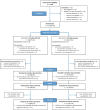2% chlorhexidine gluconate aqueous versus 2% chlorhexidine gluconate in 70% isopropyl alcohol for skin disinfection prior to percutaneous central venous catheterisation: the ARCTIC randomised controlled feasibility trial
- PMID: 37907266
- PMCID: PMC10894828
- DOI: 10.1136/archdischild-2023-325871
2% chlorhexidine gluconate aqueous versus 2% chlorhexidine gluconate in 70% isopropyl alcohol for skin disinfection prior to percutaneous central venous catheterisation: the ARCTIC randomised controlled feasibility trial
Abstract
Objective: Catheter-related sepsis (CRS) is a major complication with significant morbidity and mortality. Evidence is lacking regarding the most appropriate antiseptic for skin disinfection before percutaneous central venous catheter (PCVC) insertion in preterm neonates. To inform the feasibility and design of a definitive randomised controlled trial (RCT) of two antiseptic formulations, we conducted the Antiseptic Randomised Controlled Trial for Insertion of Catheters (ARCTIC) feasibility study to assess catheter colonisation, sepsis, and skin morbidity.
Design: Feasibility RCT.
Setting: Two UK tertiary-level neonatal intensive care units.
Patients: Preterm infants born <34 weeks' gestation scheduled to undergo PCVC insertion.
Interventions: Skin disinfection with either 2% chlorhexidine gluconate (CHG)-aqueous or 2% CHG-70% isopropyl alcohol (IPA) before PCVC insertion and at removal.
Primary outcome: Proportion in the 2% CHG-70% IPA arm with a colonised catheter at removal.
Main feasibility outcomes: Rates of: (1) CRS, catheter-associated sepsis (CAS), and CRS/CAS per 1,000 PCVC days; (2) recruitment and retention; (3) data completeness.
Safety outcomes: Daily skin morbidity scores recorded from catheter insertion until 48 hours post-removal.
Results: 116 babies were randomised. Primary outcome incidence was 4.1% (95% confidence interval: 0.9% to 11.5%). Overall catheter colonisation rate was 5.2% (5/97); CRS 2.3/1000 catheter days; CAS 14.8/1000 catheter days. Recruitment, retention and data completeness were good. No major antiseptic-related skin injury was reported.
Conclusions: A definitive comparative efficacy trial is feasible, but the very low catheter colonisation rate would make a large-scale RCT challenging due to the very large sample size required. ARCTIC provides preliminary reassurance supporting potential safe use of 2% CHG-70% IPA and 2% CHG-aqueous in preterm neonates.
Trial registration number: ISRCTN82571474.
Keywords: Infectious Disease Medicine; Microbiology; Neonatology; Sepsis.
© Author(s) (or their employer(s)) 2024. Re-use permitted under CC BY. Published by BMJ.
Conflict of interest statement
Competing interests: None declared.
References
-
- Clarke P, Craig JV, Wain J, et al. . Safety and efficacy of 2% chlorhexidine gluconate aqueous versus 2% chlorhexidine gluconate in 70% isopropyl alcohol for skin disinfection prior to percutaneous central venous catheter insertion in preterm neonates: the ARCTIC randomised-controlled feasibility trial protocol. BMJ Open 2019;9:e028022. 10.1136/bmjopen-2018-028022 - DOI - PMC - PubMed
Publication types
MeSH terms
Substances
LinkOut - more resources
Full Text Sources
Medical

